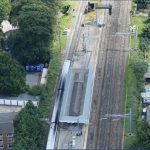Case study: Burnham Station
Background:-
Burnham Station is located between Slough in Berkshire and the Buckinghamshire town of Taplow, serving the up and down relief lines for the Great Western Main Line.
The station building and its two operational platforms were located on a raised embankment, approximately 4.5m above the surrounding land area which, over the years, had created major access issues for a range of People with Reduced Mobility (PRM) including mothers with prams to the disabled and elderly infirm.
Challenge
There was no lift at Burnham Station and pedestrian access to the platforms and main building was from the station drop off area via a subway and staircase. There was a situation where some people – unable to physically use Burnham station – had to travel to the next stop then take a taxi back. Consequently, one of the engineering goals was to facilitate the construction of a new lift shaft in order to provide step-free access to platforms.
Solution
A piled wall was required to support excavation for the new shaft, lift lobby and staircase and initial thinking had been to use sheet piling. However, research by HBPW determined that a contiguous bored pile wall was not only stronger but took considerable cost out of the project and improved construction methodology.
“There have been a range of works at Burnham station,” said HBPW’s Project Engineer, “including widening the access staircase. We also increased the size of the individual steps to 300mm, and all of this was done whilst maintaining full operational capacity at the station thanks to a series of innovative temporary works measures.”
Outcome
This was a classic example of ‘value engineering’ with Network Rail’s ‘Access for All’ programme delivering significant benefits for Persons with Reduced Mobility at Burnham Station, one of more than 200 selected for improvement.


